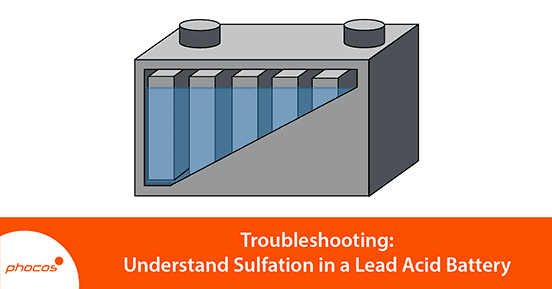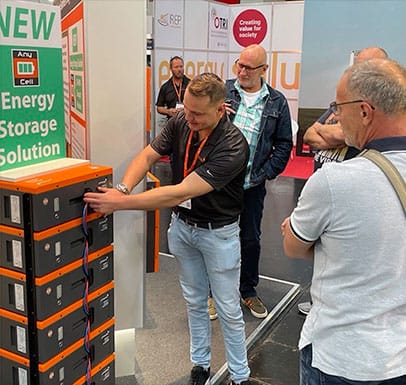
Empirical Way to Know the Sulfation Status of an Open Lead Acid Battery
When troubleshooting off-grid solar system performance, all equipment and wiring needs to be reviewed and tested. The battery bank is a vital part of the system configuration, and when sulfation occurs it can cause an interruption to optimized stored energy. Sulfation occurs when a lead acid battery is deprived of a full charge. If not corrected, sulfation can damage the battery, shortening the battery life.
This article addresses the topic of sulfation with lead acid batteries and is meant to inform. If sulfation is a concern, please be sure to work with a trained professional to rectify this issue. Electricity and battery technology should be respected, and Phocos encourages safety to be a priority. The goal will be to calculate the voltage of each cell, then measure the total voltage from positive to negative post to understand the voltage difference. The bigger the difference, the bigger the problem. Once identified, the goal will be to clean the plates of sulfation, equalize if needed and get the battery operating as designed.
Identifying the Challenge:
To measure the status of an open lead acid battery, one of the biggest inconvenience is that even though we can measure the density of each cell, often we can only measure the total voltage of the battery and not the voltage of each cell.
For example, many have gone into a car and the internal light will turn on, but when we try to turn on the car engine, not only it does the car not turn on, but while we have the key active in the ignition, the internal light goes off. This is a symptom that your car battery is heavily sulfated. Some refer to this as, ‘batteries that do not retain their charge.’
Important Relationships for Lead Acid Batteries:
Voltage in Open Circuit ∝ Density
Open Circuit Voltage ∝ Charge Status
Density ∝ Charge Status
Voltage in Open Circuit ≈ Density + 0.845 (0.845 is an empirical number. If not exact it will be very close in all lead acid battery calculations. However, one can ask the battery manufacturer for this 0.845 number, to confirm. Using a different battery specific empirical number, will result in minimal changes, and not really impact results to define a good cell or a bad cell).
Putting these formula relationships into real world examples:
Let’s say we have a 6 Vdc open lead acid battery. There will be 3 cells as each one will be about 2 Vdc each. If 12 Vdc there will be 6 cells. We measure Specific Gravity (SG) in each cell. The SG will go from 1.000 (that is pure water), to about 1.850. The SG of a 97% solution of sulfuric acid at 60 degrees Fahrenheit is 1.84.
In our example we got 1.200, 1,150, 1.125. Using the relationship of: Voltage in Open Circuit ≈ Density + 0.845 We can say that the voltage on each cell is about: 2.045, 1.995, 1.970 for a total of 6.010 Vdc
Let’s say we measure the battery voltage, with a voltmeter and got 6.220 Vdc. With this voltage the battery may look like it is charged about 75%, depending on the manufacturer. But using the individual calculated voltages we calculated 6.010 Vdc. The difference is the “sulfation”. A short explanation is sulfuric acid molecules are “stuck” in the lead, rendering that space (of the plates) worthless. This results in lost battery capacity, and less autonomy. The best way to solve this problem is to clean the plates, or remove the molecules stuck inside the lead. We accomplish this with a slow charge, 2% – 3% of C20 (capacity at 20 hours) in Amps for 24 to 48 hours, or sometimes longer.
As an alternative, please note, there are de-sulfating machines on the market but one must be very careful when using these machines. There are complex relationships that must be understood, in order not to damage the battery while trying to fix the sulfation issue. Only work with an expert who understands these machines and these complex relationships.
Of course, in this example, the battery will need equalization as the SG or density in cells are very different. At the end of this process, the SG in all cells should be the same or very close one to another.
AGM or Gel Cell Battery – When you can’t measure the Specific Gravity, what do you do?:
What can be done for sealed lead acid batteries, when there in no way of measuring SG? The only option is to assume sulfation exists and try to de-sulfate with the same 2% – 3% of C20 in Amps for 24 to 48 hours. During this process, the batteries should not get hot. If needed, put the sealed lead acid battery in some water, taking care not to get water too close to the top of the battery.
Please remember, as with people, batteries are what they eat. Always request from your battery manufacturer the charging parameters. For best performance, it is critical trying to keep lead acid batteries at about 77° F or 25° C, for maximum battery life. As a general rule, for each 10° C over 25° C, the lead acid battery’s life will be reduced by 50%. Extreme heat is a major concern and should be considered and rectified whenever possible. Some individuals use air-conditioned offices or air-conditioned equipment rooms, to keep temperatures managed. If that is not possible, people should consider placing batteries in the shade when conditions allow and keep the battery storage area well ventilated. The use of fans can also be an option to keep the batteries operating in the ideal temperature range.
This effort and attention to care for lead acid batteries in a solar off-grid or battery backup system, will be rewarded. Not only will the maximum monetary investment will be realized, but the equipment loads and people relying on the equipment, will enjoy the best performance.












